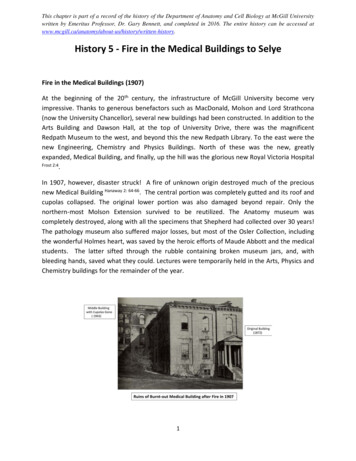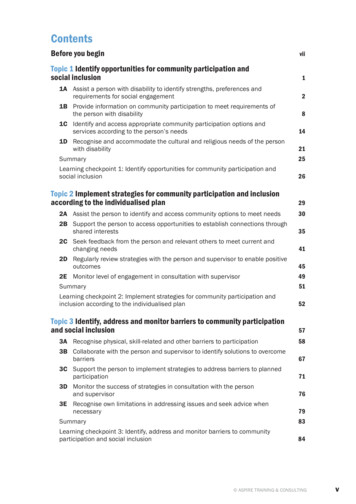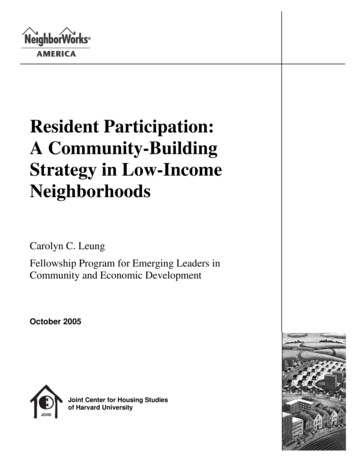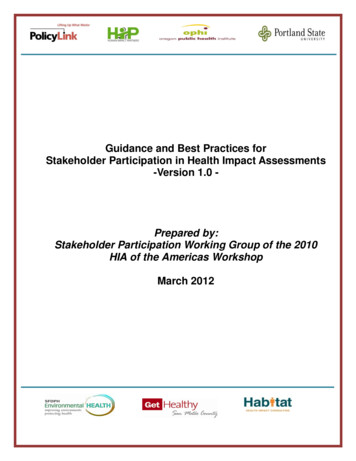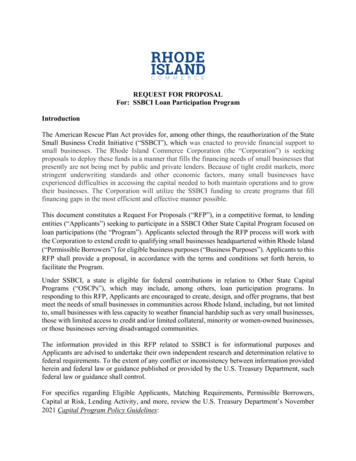
Transcription
2.0. Community Participation2.1.DefinitionThe focus of this chapter is to provide an explanation for the term“community participation,” a concept central to this research report. The definitionspresented by various theorists have been presented in an effort to give acomprehensive overview of the term. Following closely the definition of communityparticipation, are also discussed critical issues related to it such as the stages andlevels of participation and the need for it.Participation does not necessarily imply self-help home building byundernourished and over-worked people without credit, with inadequate toolsand poor materials . . . The central issue is that of control and power to decide.John F.C. Turner in Housing by People (133).The discussion of community participation in architecture, first initiated in the1960s, became a buzzword in mid-1970s after the sites and services housing schemesreceived funding and acceptance by the World Bank in the developing countries(Hamdi, Housing 76). However, it is important to understand the meaning ofcommunity participation as it has been misused and abused in many projects claimingto have community participation as a project component. First understanding themeanings of the words ‘community’ and ‘participation’ individually can best explainthe term ‘community participation’. Nick Wates defines the word community in The11
Community Planning Handbook, as a group of people sharing common interests andliving within a geographically defined area (184). Nabeel Hamdi in his book (withReinhard Goethert), Action Planning for Cities: A Guide to Community Practice,points out that the term community has both “social and spatial dimensions” and thatgenerally the people within a community come together to achieve a commonobjective, even if they have certain differences (Hamdi, Action 67). The concept of acommunity works on the age old principles of ‘unity is strength’ and ‘united westand’. A group of people always has advantageover a single individual in getting his or hervoice heard, especially in the case of have-notsof the society.Charles Abrams in his book, TheLanguage of Cities: A Glossary of Terms,defines community as, “that mythical state ofsocial wholeness in which each member has hisplace and in which life is regulated bycooperation rather than by competition andconflict” (60). It is clear that a communitygenerally has two certain elements, that is,physical boundaries and social interests commonamong the people. On the other hand, acommunity sometimes may have one elementBox 1. Charles AbramsBorn in 1902, CharlesAbrams made pioneeringcontributions to the area ofhousing trends and land issuesin both the developing anddeveloped world through hisnumerous books including,The Future of Housing(1946), Forbidden Neighbors:A Study of Prejudice inHousing (1955), Housing inthe Modern World (1964),Man’s Struggle for Shelter inan Urbanizing World (1964),The City is the Frontier(1965) and The Language ofCities: A Glossary of Terms(1971). He also held teachingpositions at ColumbiaUniversity and MIT as well asbeing an advisor andconsultant for the UnitedNations, the Agency forInternational Developmentand several governmentsworldwide (Abrams, City395).dominating the other, for example, a community12
of students or a community of artists generallyneed not belong to the same physicalBox 2. Nick Watesboundaries. In this case, they come together oncertain ideological grounds.Nabeel Hamdi presents an opposingview that the communities are not necessarilyalways organized and cohesive and sometimeslack the “sense of community” and “socialidentity” (Hamdi, Action 67). He explains thatfor community participatory projects, it is not amust to have an already well organizedcommunity right from the beginning but thesense of community can be achieved during thecourse of the project, which can also be one ofthe objectives of including communityparticipation in development projects (Hamdi,Action 67). Charles Abrams gives a goodexample of the sense of community in the caseof people living in a squatter settlement. Thesesquatters, living within the confines of the samesettlement, have common objectives and worktogether to protect and legalize their dwellings.Born in 1951, Nick Wates isone of the world’s leadingconsultants of communityplanning and architecture. Hereceived his professionaltraining in architecture andplanning from UniversityCollege London in 1975 andhas been involved in research,writing, consultancy and thepractice of communityplanning for a good 25 years.His major literary contributionsinclude, The Battle for TolmersSquare (1976), Squatting, theReal Story (1980), CommunityArchitecture (with CharlesKnevitt 1987), Action Planning(1996) and The CommunityPlanning Handbook (2000).His firm ‘Nick WatesAssociates’ offers variousdesign, training and researchservices at both the nationaland international levels. Hecurrently resides in Hastings,England (Nick).Photo from Nick Wates, 2000:230.Their survival against the authorities rests upon13
cooperation among them and hence, the sense ofBox 3: Nabeel Hamdicommunity is strengthened by their commongoals. Compare this with the generally nonexistent sense of community among the residentsof a posh neighborhood with the best physicalform of housing (Abrams, Language 203).The word participation can be defined asthe “[a]ct of being involved in something”(Wates, Handbook 194). According to N.JHabraken, participation has two definitions withopposite meanings. Participation can eitherrepresent assigning certain decisive roles to theusers, where they share the decision-makingresponsibility with the professionals. The othertype of participation is where there is no shift ofresponsibilities between the users andprofessionals but instead only the opinion of theuser is considered while making decisions(Habraken, “Towards” 139).Community participation means someform of involvement of people, with similarneeds and goals, in decisions affecting theirlives. Charles Abrams defines communityTrained as an architect, NabeelHamdi has been involved inseveral research andconsultancy projects in boththe developing and thedeveloped countries of theworld. He was the architect of1970s widely acclaimed,community-based PSSHAKhousing projects in Londonand is the recipient of severalawards for his contributions.Hamdi also held a teachingposition for 10 years at MIT,US and is currently the CoDirector of the Centre forDevelopment and EmergencyPractice and the Director ofHousing and UrbanDevelopment at OxfordBrookes University, UK. Hehas authored 4 books whichinclude: Making Micro Plans:A Community Based Processin Programme Making andDevelopment (1988); HousingWithout Houses: Participation,Flexibility, Enablement (1991);Educating for Real: TheTraining of Professionals forDevelopment Practices(1996), Action Planning forCities: A Guide to CommunityPractice (with ReinhardGoethert 1997) (Centre forDevelopment).Photo from DFID, Removing.14
participation as, “[t]he theory that the local community should be given an active rolein programs and improvements directly affecting it” (63). It is only rational to givecontrol of affairs and decisions to people most affected by them. Besides, since nogovernment or authority has the means to solve all the public problems adequately, itis necessary to involve people in matters that affect them (Abrams, Language 63).However, delegating powers to people is not an easy task and involves great inquiryinto the change in the attitudes of the authorities and professionals, which isaddressed in the next section. Nabeel Hamdi defines community participation as apowerful idea which “refers to the process by which professionals, families,community groups, government officials, and others get together to work somethingout, preferably in a formal or informal partnership” (Hamdi, Housing 75). Heexplains that community participation was initially an outcome of the public pressuredemanding “environmental justice” (Hamdi, Housing 76).The advocates of community participation believe that it brings many lastingbenefits to people instead of only a means of getting things done. Sherry R. Arnsteinassociates citizen participation with citizen power and control as, “the redistributionof power that enables the have-not citizens, presently excluded from the political andeconomic processes, to be deliberately included in the future” (216). ChristopherAlexander explains that participation is “inherently good” and that it brings peopletogether in creating and making decisions about their environment (Oregon 40). Sincepeople are actively involved in the process, Alexander argues that participation helpspromote sense of ownership and control among the people (Oregon 41).15
2.2.Stages And LevelsIn order to expand the discussion of community participation further, it isimportant to develop an understanding of the different phases or stages of the housingprocess. John F.C. Turner divides the process into three basic components; planning,construction and management (Housing 28). Nabeel Hamdi adds two more stages tothe overall process; initiation, planning, design, implementation and maintenance.Initiation is the first stage of the process where the project goals and scope aredefined. The planning stage involves working out the project details, budgeting andresource identification. In the design stage, the details are further developed, with theactual execution of the project in the implementation or construction phase. Themaintenance or management stage is a long-term process and involves the upkeep ofthe project (Hamdi, Housing 72). The involvement of communities at different stagesof the project determines the level of participation in projects.Probably the best way to explain different levels of participation in terms ofcommunity involvement in various stages of the projects is by understanding whatSherry R. Arnstein calls “A Ladder of Citizen Participation,” which she introduced inan article published in 1969 in the Journal of the American Planning Association.Arnstein explains that this classification is necessary to unveil the manipulation ofpeople in the garb of community participation projects by professionals andpolicyholders. The ladder has eight rungs each corresponding to a different level ofparticipation, that is, manipulation, therapy, informing, consultation, placation,partnership, delegated power and citizen control as shown in fig. 2.1. The rungs at the16
bottom of the ladder are the ones with least citizen participation or “nonparticipation” and include Manipulation and Therapy. Informing, consultation andplacation occupy the middle rungs of the ladder and border between manipulation atthe bottom and citizen control at the top and is termed as “tokenism” where thepeople are allowed to participate only to the extent of expressing their views but haveno real say that matters. The last three rungs, partnership, delegated power and finallycitizen control at the top of the ladder, are termed equivalent to “citizen power” andthis is where true and meaningful participation takes place. This categorization of thevarious types of people involvement is extremely crucial in clarifying the confusionbetween “non-participation” and true “citizen power” and to identify the real motivesbehind participatory projects, which are often used by critics as shortcomings of theconcept of community participation.Fig. 2.1. Eight Rungs on the Ladder of Citizen Participation, illustration from SherryR. Arnstein, 1969: 217.17
2.3.Top-Down Versus Bottom-Up ApproachesBroadly speaking, community participation can be of two types; in the form oftop-down programs or bottom-up initiatives (Moser, Community 91). These twoprocesses are the exact opposites of each other and differ on the basis of whethergovernments/implementing agencies or the communities have the overall control ofthe program. John F.C. Turner elaborates the top-down and bottom-up approaches bycomparing them with the ‘heteronomous housing systems’ and the ‘autonomoushousing systems’ respectively (Housing 27). He explains his concept by using thediagrams as shown in fig. 2.2, where the difference between the two systems is in thedecision-making power of different actors at different stages of the housing process.Fig. 2.2. Autonomous Housing Systems versus Heteronomous Housing Systems,illustration from John F.C. Turner, 1977: 27.In the case of the heteronomous system, John F.C. Turner explains that thegovernment decides and provides housing for the people in a top-down process while18
the autonomous system follows a bottom-up approach and has different networks ofactors working alongside in different relationships.B.L.C. Johnson in his book, Development in South Asia, explains the topdown and bottom-up developmental approaches using a simple example of theconstruction of a dam and the improved agricultural production as a result (15). Inmost cases, the dam construction is a top-down development process where all thedecisions are made by the government or other agencies without seeking the consentof the people. Johnson explains that there can be a bottom-up development as wellwhere the people may decide to adopt modern agricultural technologies to improvethe overall production. Now these are two different kinds of developments, one isimposed while the other is self-chosen by the people. Johnson points out that therecan sometimes be an overlap between top-down and bottom-up development, in thiscase, the government’s decision to improve the water supply system overlaps with thepeople’s decision to adopt new technology.2.4.The Partnership ApproachC.O.N. Moser explains in Community Participation in Urban Projects in theThird World, that by the end of the 1960s, bottom-up community participationinitiatives started to surface along with top-down participation programs in the formof squatter settlements around the world. These bottom-up initiatives of thecommunity in order to house themselves resulted after the failures of top-downhousing projects in different cities of the world and were initially met with resistance19
by governments. However, Moser explains that by the 1970s, many Third Worldgovernments and donor agencies realized the potential of these community-basedinitiatives which resulted in a major change of approach in housing in the form ofupgrading and sites and services projects.G. Narayana Reddy in his book Empowering Communities throughParticipatory Methods, explains that in the top-down model of participation, thegovernments decide and provide for the communities which develops a sense ofdependency and lethargy among the people as shown in the fig. 2.3. He presents analternative to the top-down model in the form of a “partnership model” where thegovernments and communities work together in planning and decision-making withlong-lasting results as shown in fig. 2.4 (Reddy 5-6).This discussion gives rise to the question related to the objective thatcommunity participation is meant to achieve. C.O.N. Moser explains the concept ofparticipation as a ‘means’ and as an ‘end’ in development projects,Where participation is interpreted as a means it generally becomes a formof mobilization to get things done . . . Where participation is identified asan end the objective is not a fixed quantifiable development goal but aprocess whose outcome is an increasingly ‘meaningful’ participation inthe development process. 22C. Moser, “The problem of evaluating community participation in urbandevelopment projects,” Evaluating Community Participation in Urban DevelopmentProjects, Development Planning Unit Working Paper No. 14 (1983): 3 qtd. in Moser,Community 84.20
TOP-DOWN MODELGiving everything forfreeDoing everything forthemCommunityDependencyLethargyFig. 2.3. Top-down Model, illustration by G. Narayana Reddy, 2002: 6.PARTNERSHIP MODELControl over their affairsPlanning and decisionmaking togetherWorking and benefitingtogetherPermanent PartnershipDignity to the poorCommunitySustainability of projectFig. 2.4. Partnership Model from G. Narayana Reddy, 2002: 6.From the above discussion it can be concluded that community participationcan be used to achieve material benefits in the form of pointed development projects(sewerage, water supply delivery, etc) or can lead to the social development of thepeople (empowerment, independence, etc). In the current context of maximizingopportunities for community development, it is important that participation be used asa tool for achieving something more meaningful than mere physical benefits. C.O.N.Moser elaborates the need of “[i]dentification of the process whereby participation as21
a means has the capacity to develop into participation as an end” (Moser, Community84).However, in addition to identifying the effectiveness of communityparticipation, it is equally important to recognize some of the problems involved inparticipatory development approaches. Participation employed as an end indevelopment projects is a time-consuming process and since time is directlyproportional to money in such situations, it is quite difficult to justify such anapproach due to high expenditures (UNDP). Besides, there is a fear amonggovernments of uncontrolled empowerment of people and lack of trust in their abilityto make sensible decisions, which prevents the governments to change theirpaternalistic approach in decision-making. The only way that such issues againstparticipation can be resolved is by looking at participation from a broader perspectiveand by weighing its benefits versus limitations. It is true that it would take more timefor a fully participatory project to accomplish its goals but the end result in the formof community empowerment will also go a long way. Social benefits are far superiorto physical benefits and a realization has to be made on part of the implementingagencies that the empowerment of people is necessary for enabling people to becomeproductive citizens. The authorities need to change their attitude towards people, onone hand while on the other hand; the people need to be guided for participation andmaking informed decisions. Professionals such as the architects and planners canperform a crucial role here and act as mediators and teachers in community-basedprojects. The role of the architect in community-based projects is discussed in detailin the next chapter. This discussion is also accompanied by an extensive literature22
review of the views of pioneering theorists on community participation in architecturewhose work contributed and guided the development of the Community ArchitectureMovement.23
physical boundaries and social interests common among the people. On the other hand, a community sometimes may have one element dominating the other, for example, a community Box 1. Charles Abrams Born in 1902, Charles Abrams made pioneering contributions to the area of housing trends and land issues in both the developing and



